HIV/AIDS epidemic hits Long Island Black and Latino communities hardest
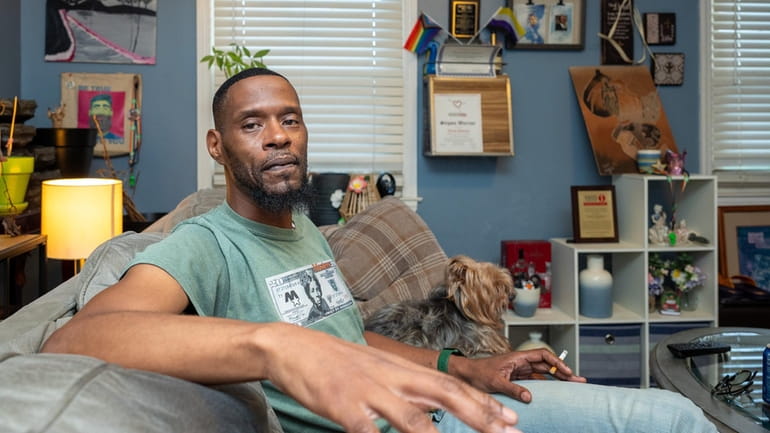
New HIV cases and AIDS-related deaths have fallen significantly in recent years, but on Long Island and nationwide the epidemic continues to hit Black and Latino communities harder than white and Asian ones.
A Black Long Islander is seven times more likely to have been diagnosed with HIV as a white resident, state Department of Health data shows. A Latino resident is three times more likely. State and national gaps are similar.
Disparities exist throughout the health care system, but few are as stark as those related to HIV.
“There are two different epidemics,” one for Black and Latino people, one for other Americans, said Kamila Alexander, an associate professor at the Johns Hopkins University School of Nursing in Baltimore who studies HIV disparities.
Experts say higher rates of poverty, housing insecurity and incarceration, and less access to health care, help explain the continuing chasm. Distrust of the health care system and the societal stigma that HIV carries are among other factors.
Since the HIV/AIDS epidemic began in 1981, more than 700,000 Americans have died of the disease, but attention to it has waned as deaths plummeted following the development of lifesaving medications. Yet thousands still die of HIV-related causes every year, and studies show people with HIV are more susceptible to lung disease, stroke, diabetes, dementia and other medical conditions.
“There are a lot of people who are completely oblivious to the fact that HIV is still an epidemic in America,” said Deja Abdul-Haqq, communications director for the Los Angeles-based Black AIDS Institute. She said that’s largely because it’s centered in Black and Latino communities.
Black people have had higher rates of HIV since the 1980s, but “Black communities were not a priority until 20 years after the epidemic started,” and that widened the racial gap, Abdul-Haqq said. More than 40% of Americans with HIV were Black in 2019, even though only 13% of the U.S. population was Black, CDC data shows.
HIV’s racial gap is even greater for women than it is for men: Nationwide in 2019, 54% of women diagnosed with HIV were Black, CDC data shows.
On Long Island, the rate of HIV among Black residents was 631 diagnosed cases per 100,000 people in 2021, and the rate among Latinos was 283 cases. That compares with rates of 95 for white people and 70 for Asians, according to state data.
One of the reasons for the drop in new HIV cases is powerful drugs that block transmission, but Black and Latino people at higher risk for HIV are much less likely to be prescribed those medications for multiple reasons, including access, experts say.
Once Black and Latino people are diagnosed with HIV, they are less likely to take different, post-infection medicines that can reduce the level of virus in their bodies to undetectable levels, which prevents HIV transmission to others.
There has been some progress. New cases in recent years fell more among Black and Latino Long Islanders than among whites. That led the rate of people living with HIV on the Island to decrease 9% for Black people, 12% for Latinos and 5% for white people between 2011 and 2021, state statistics show. The rate for Asians — who have the lowest prevalence of HIV — more than doubled, caused by an increase in the relatively small number of cases.
But the epidemic still impacts Black and Latino people more heavily.
There were nearly as many Black Long Islanders — 1,874 — with HIV in 2021 as whites — 1,973 — despite a white population that was nearly seven times higher, state and Census Bureau data show. There were 1,261 Latinos with HIV. Long Island was 61% white, non-Hispanic, 9% Black, non-Hispanic, and 19% Latino in 2021.
There were 168 Asians with HIV, or 3.1% of cases; Long Island's population was nearly 8% Asian. Multiracial people, Native Americans, Pacific Islanders and people whose race or ethnicity were unknown had fewer than 2% of HIV cases.
Nearly half of Long Island HIV cases, which totaled 5,370, were among men who have sex with men, and just under a third were from heterosexual contact, with the rest from injection-drug use or unknown, state data shows.
Tyrone Banister, 51, of Lynbrook, who is Black and gay, said he “was on the verge of dying” when he was hospitalized in 2006 with pneumocystis pneumonia, bronchitis and almost no T-cells, a critical part of the immune system.
Today, he takes one pill a day for HIV, and his viral level is undetectable.
“I’m living my best life,” Banister said. “I have been positive for 17 years and I haven’t let it stop me."
Uriel Loman, 32, of Freeport, a gay Mexican immigrant, said that for him, “Undetectable truly means I can live the life I was living before the diagnosis, but just taking better care of myself and not going off the treatment."
If people who are undetectable or “virally suppressed” stop taking their medications, their virus levels quickly increase.
In the 1980s, AIDS was viewed as a death sentence, and fear of even touching people with HIV was rife. In the mid-1990s, the release of potent medications and drug combinations caused HIV-related deaths to fall sharply.
Nationwide, fewer than 5,000 people died directly from the disease in 2021, down from nearly 7,700 in 2011 and more than 43,000 in 1995, the peak year for HIV-related deaths, according to CDC data.
On Long Island, 19 people died of HIV-related causes in 2021, compared with 32 in 2011 and 390 in 1994, CDC data shows.
Dr. Joseph McGowan, who oversees HIV services for Northwell Health, said the few HIV-related deaths at Northwell in recent years have been among people who either were not diagnosed with AIDS until the virus already had ravaged their bodies, or had declined to take HIV medications. HIV causes AIDS, which is diagnosed when T-cells fall low enough, or when a serious HIV-related infection develops.
Patricia Hayes, 67, a Black woman from Hempstead with HIV who does volunteer peer outreach for Northwell, said the same medications that allow her and others to live relatively normal lives have made prevention efforts more challenging.
“Now with the younger population, it’s kind of scary — a lot of them have started saying, ‘HIV, you just get a pill now?’ The fear is not there with young people anymore,” she said.
HIV remains dangerous, McGowan said. People with HIV tend to have more chronic conditions when they get older and are more likely to die younger from strokes, cardiovascular disease and other conditions, he said. Even when HIV is not listed on death certificates, the virus may have contributed to death by damaging the immune system, he said.
“If you can get on to treatment when your immune system is still relatively intact, you could avoid a lot of these chronic comorbidities,” McGowan said.
Northwell and other Long Island health care providers and organizations focus many of their HIV prevention efforts on Black and Latino communities. But they face major challenges in further reducing HIV transmission.
One is that people are more likely to have sex with others of the same race or ethnicity, McGowan said. There’s no significant racial difference in how many sexual partners people have, but with HIV much more prevalent in Black and Latino communities, Black and Latino people are more likely to have sexual contact with an HIV-positive person, he said.
Compounding this higher risk, Black and Latino people are less likely to take a pre-exposure prophylaxis medication, known as PrEP, that reduces the risk of contracting HIV through sex by 99% when used as prescribed.
Only 11% of Black people and 21% of Latinos "who could benefit from" the preventive medication were prescribed it in 2021, compared with 78% of whites, the CDC says.
“When PrEP came out, it was embraced by the white, gay community,” said Maria Pyra, an assistant professor of medical social sciences and preventive medicine at Northwestern University's medical school in Chicago who studies PrEP access. “Then came the perception that ‘it’s for that group and it’s not for my group of friends or my social circle.’ ”
In addition, the initial focus of recommending PrEP primarily to men who have multiple male sexual partners, and of clinical trials that were limited to men, meant “women didn’t even think it was for them,” Alexander said.
Many health care providers don’t know about the medication, with knowledge lower in suburban areas than in cities, and among gynecologists, Pyra said.
Educating Black and Hispanic clinicians about PrEP is especially important, because many people prefer doctors of their own racial and ethnic background, said McGowan, who is helping develop a sexual health and PrEP curriculum for Northwell.
Yet relatively few providers are Black or Latino, and doctors and nurses who aren't have to put in “extra work to build that relationship” and “learn more about what the patient’s life is really like” to provide the most effective preventive and medical care, Alexander said.
“The patient has to get to a place where they feel comfortable enough to open up and disclose enough information so that the provider can tailor that care toward prevention,” she said. “If people are not welcomed or not believed or listened to, experience discrimination and bias from the minute they walk in the door, then they're also not likely to engage or be able to receive the health care that they need.”
Socio-economic status also is a potential barrier to treatment and prevention, said Dr. Janice Verley, who until December was director of the HIV/AIDS program at Nassau University Medical Center, a public hospital in East Meadow. Even as a Black woman, she had to work to gain the trust of some of her low-income patients of color, who won't go to doctors they believe look down on them and make them feel uncomfortable.
“It's sort of like, ‘You live in your home and you drive your car, and you have three meals a day and you go on vacations, you have on a white coat, what do you really know about the struggles that I have, and living in a shelter or living on the street?” Verley said.
Distrust of the medical establishment remains common among Black Americans, because of historic injustices such as experiments done on Black people several decades ago, and attitudes today, like how, as documented in research, doctors are more likely to underestimate the pain of Black patients and prescribe less pain medication, Abdul-Haqq said.
Language and cultural differences are other potential hurdles, said Dervis Pulgar, sexual health services manager at the Bellmore-based LGBTQ group PFY, part of the Long Island Crisis Center. Many PFY clients are immigrants from countries where there is greater stigma than in New York toward LGBTQ and HIV-positive people, he said.
“It’s a really big challenge to work with this community," so the sexual-health services staff is entirely bilingual, with three of four staff members Latino and one a transgender Latina woman, said Pulgar, a Venezuelan immigrant.
“They can identify with us, because we are Latinos, too,” he said. “We have the same culture, the same language, the same thinking.”
Loman, the Freeport resident, said when he led a Spanish-speaking LGBTQ support group at PFY, immigrants, especially undocumented ones, said they didn’t regularly see doctors or seek HIV testing because they didn’t have insurance. He told them about free HIV tests and low-cost medical care.
Loman said his HIV infection would have been caught earlier if he didn’t mistakenly believe a test was expensive. He got diagnosed with HIV only after he went to the hospital in 2013 with severe stomach pain. Today, he still has “really bad gastritis” and irritable bowel syndrome, and doctors told him it was because of how low his T-cell level had fallen.
“My stomach situation probably would have been totally different if I had been in treatment sooner,” he said.
Black and Latino communities have higher rates of poverty than white and Asian ones, and HIV disproportionately strikes the poor.
Low-income people have more stressors in life, “trying to keep a roof over your head, trying to keep food in your mouth and your children’s mouths,” said Juanita Carter-Fuller, 66, a Black HIV-positive woman who lives in Wyandanch and is a community outreach specialist for Northwell’s Center for AIDS Research and Treatment.
For them, HIV testing or care may not be a priority, so Northwell helps connect them with stable housing, jobs and other services, McGowan said.
Patchogue-based Thursday’s Child, which offers HIV prevention and services, focuses much of its HIV testing in communities with large Black and Latino populations, program manager Kerry Thomas said.
On a recent afternoon at the Family Service League health center in Bay Shore, Thursday’s Child HIV testing program specialists Neika Chery, who speaks Haitian Creole, and Jennifer Jara, who speaks Spanish, were staffing an HIV-testing table.
“Seeing someone that's Black, or seeing someone that's Hispanic, or someone that represents them, it makes it more comfortable to come to our tables, ask questions, and get testing, which is the goal, so we can help them get services if they're positive,” Chery said.
Long Beach-based Círculo de la Hispanidad, which offers an array of HIV services, weaves some of its HIV prevention and education into other initiatives, including English as a Second Language classes, HIV program director César Nuesi said. All ESL students hear the presentations, under the philosophy that “any human being who is sexually active can be at risk for HIV and STDs,” he said.
Prevention outreach to women is especially challenging, because many “see themselves at low risk,” said Barbara Martens, who manages community engagement for Northwell’s AIDS services. “The problem is that their sexual partners are not.”
The most effective HIV messaging toward people of color is narrowly targeted — for example, toward Black women, to underline that they, too, are at risk, Abdul-Haqq said.
One-on-one engagement can be especially effective, she said.
Northwell trains barbers, beauticians and others in communities of color with higher HIV rates to talk to clients about HIV, and to distribute condoms and educational materials, Martens said. Testing vans periodically are set up outside the businesses. Northwell also has “social media influencers” in those communities to promote events and materials, McGowan said.
Societal stigma toward LGBT and HIV-positive people leads some to avoid getting tested or, once they’re HIV-positive, to shun care, doctors and HIV outreach workers said.
“They’re looking around hoping that nobody will see them walk into a van to get tested,” Carter-Fuller said.
That same stigma means that people who live with their families may not want to get a PrEP or HIV-medicine prescription for fear the pills will be discovered, she said.
Stigma exists in white as well as Black and Latino communities, Alexander said. But in low-income communities of color, that stigma is magnified by other issues, so someone who hides their HIV status won’t ask to borrow a car or money for a medical appointment, she said.
On Long Island, spotty bus service makes it less likely people without cars will go to the doctor, Nuesi said.
“If you don’t drive, it can take you half the day, one day, for your medical appointment,” so Círculo provides ride-share, taxi and other services, he said.
Those appointments often are far from people’s homes because major health care providers typically don’t have offices and clinics in the low-income areas where HIV risk is highest, preferring to locate where more people have private insurance, McGowan said.
Someone without insurance is less likely to have a primary care provider who could diagnose HIV early on, before the virus does too much damage to the body, and before someone may unknowingly spread the virus to others, he said.
Nonprofit federally qualified health centers in both counties serve many people without insurance or with Medicaid.
Pam Biafora is a peer adherence worker for one of them, Sun River Health, which has centers across Suffolk.
Biafora, who has been HIV-positive since 1986 and is of half Puerto Rican ancestry, regularly reviews HIV-positive patients’ charts and calls them if they’re overdue for an appointment — and delves into why. “There’s a safe space” when she talks with a fellow HIV-positive person, she said.
Biafora, 60, is grateful to have survived, when so many who got HIV in the 1980s died. But she mourns how she was not able to fulfill her dream of having a child.
Unlike today, when HIV medicine taken while pregnant and given to a newborn reduces the risk of maternal transmission to less than 1%, according to the CDC, the probability was much higher during Biafora’s childbearing years. She did not want to take the chance of having an HIV-positive baby.
“That’s been my biggest regret,” she said, “something I just can’t forgive HIV from taking away from me.”
New HIV cases and AIDS-related deaths have fallen significantly in recent years, but on Long Island and nationwide the epidemic continues to hit Black and Latino communities harder than white and Asian ones.
A Black Long Islander is seven times more likely to have been diagnosed with HIV as a white resident, state Department of Health data shows. A Latino resident is three times more likely. State and national gaps are similar.
Disparities exist throughout the health care system, but few are as stark as those related to HIV.
“There are two different epidemics,” one for Black and Latino people, one for other Americans, said Kamila Alexander, an associate professor at the Johns Hopkins University School of Nursing in Baltimore who studies HIV disparities.
WHAT TO KNOW
- A Black Long Islander is seven times more likely to have an HIV diagnosis than a white resident, and a Latino resident is three times more likely, state data shows.
- Black and Latino people also are much less likely to take medications that are highly effective in blocking the transmission of HIV.
- Experts say higher rates of poverty and housing insecurity, and less access to health care, as well as distrust of the health care system and HIV-related stigma, help explain the gaps.
Experts say higher rates of poverty, housing insecurity and incarceration, and less access to health care, help explain the continuing chasm. Distrust of the health care system and the societal stigma that HIV carries are among other factors.
Since the HIV/AIDS epidemic began in 1981, more than 700,000 Americans have died of the disease, but attention to it has waned as deaths plummeted following the development of lifesaving medications. Yet thousands still die of HIV-related causes every year, and studies show people with HIV are more susceptible to lung disease, stroke, diabetes, dementia and other medical conditions.
“There are a lot of people who are completely oblivious to the fact that HIV is still an epidemic in America,” said Deja Abdul-Haqq, communications director for the Los Angeles-based Black AIDS Institute. She said that’s largely because it’s centered in Black and Latino communities.
Black people have had higher rates of HIV since the 1980s, but “Black communities were not a priority until 20 years after the epidemic started,” and that widened the racial gap, Abdul-Haqq said. More than 40% of Americans with HIV were Black in 2019, even though only 13% of the U.S. population was Black, CDC data shows.
HIV’s racial gap is even greater for women than it is for men: Nationwide in 2019, 54% of women diagnosed with HIV were Black, CDC data shows.
On Long Island, the rate of HIV among Black residents was 631 diagnosed cases per 100,000 people in 2021, and the rate among Latinos was 283 cases. That compares with rates of 95 for white people and 70 for Asians, according to state data.
One of the reasons for the drop in new HIV cases is powerful drugs that block transmission, but Black and Latino people at higher risk for HIV are much less likely to be prescribed those medications for multiple reasons, including access, experts say.
Once Black and Latino people are diagnosed with HIV, they are less likely to take different, post-infection medicines that can reduce the level of virus in their bodies to undetectable levels, which prevents HIV transmission to others.
There has been some progress. New cases in recent years fell more among Black and Latino Long Islanders than among whites. That led the rate of people living with HIV on the Island to decrease 9% for Black people, 12% for Latinos and 5% for white people between 2011 and 2021, state statistics show. The rate for Asians — who have the lowest prevalence of HIV — more than doubled, caused by an increase in the relatively small number of cases.
But the epidemic still impacts Black and Latino people more heavily.
There were nearly as many Black Long Islanders — 1,874 — with HIV in 2021 as whites — 1,973 — despite a white population that was nearly seven times higher, state and Census Bureau data show. There were 1,261 Latinos with HIV. Long Island was 61% white, non-Hispanic, 9% Black, non-Hispanic, and 19% Latino in 2021.
There were 168 Asians with HIV, or 3.1% of cases; Long Island's population was nearly 8% Asian. Multiracial people, Native Americans, Pacific Islanders and people whose race or ethnicity were unknown had fewer than 2% of HIV cases.
Nearly half of Long Island HIV cases, which totaled 5,370, were among men who have sex with men, and just under a third were from heterosexual contact, with the rest from injection-drug use or unknown, state data shows.
From 'on the verge of dying' to 'living my best life'
Tyrone Banister, 51, of Lynbrook, who is Black and gay, said he “was on the verge of dying” when he was hospitalized in 2006 with pneumocystis pneumonia, bronchitis and almost no T-cells, a critical part of the immune system.
Today, he takes one pill a day for HIV, and his viral level is undetectable.
“I’m living my best life,” Banister said. “I have been positive for 17 years and I haven’t let it stop me."
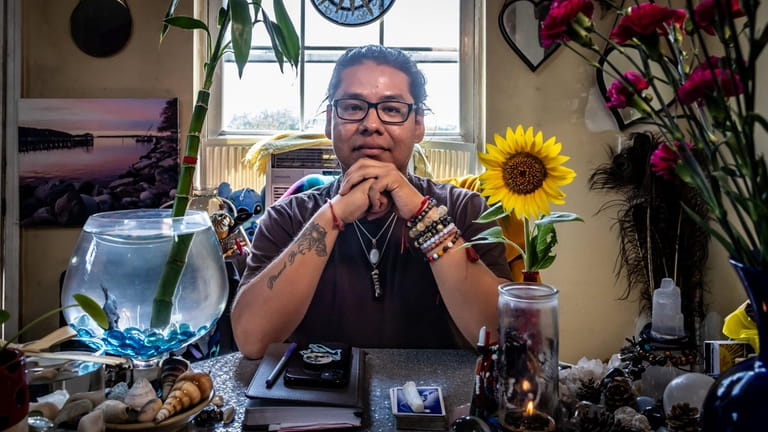
Uriel Loman, at his Freeport home Aug. 1, said his HIV infection would have been caught earlier if he didn’t mistakenly believe a test was expensive. Credit: Newsday / J. Conrad Williams Jr.
Uriel Loman, 32, of Freeport, a gay Mexican immigrant, said that for him, “Undetectable truly means I can live the life I was living before the diagnosis, but just taking better care of myself and not going off the treatment."
If people who are undetectable or “virally suppressed” stop taking their medications, their virus levels quickly increase.
In the 1980s, AIDS was viewed as a death sentence, and fear of even touching people with HIV was rife. In the mid-1990s, the release of potent medications and drug combinations caused HIV-related deaths to fall sharply.
Nationwide, fewer than 5,000 people died directly from the disease in 2021, down from nearly 7,700 in 2011 and more than 43,000 in 1995, the peak year for HIV-related deaths, according to CDC data.
On Long Island, 19 people died of HIV-related causes in 2021, compared with 32 in 2011 and 390 in 1994, CDC data shows.
Dr. Joseph McGowan, who oversees HIV services for Northwell Health, said the few HIV-related deaths at Northwell in recent years have been among people who either were not diagnosed with AIDS until the virus already had ravaged their bodies, or had declined to take HIV medications. HIV causes AIDS, which is diagnosed when T-cells fall low enough, or when a serious HIV-related infection develops.
'The fear is not there,' but HIV remains dangerous
Patricia Hayes, 67, a Black woman from Hempstead with HIV who does volunteer peer outreach for Northwell, said the same medications that allow her and others to live relatively normal lives have made prevention efforts more challenging.
“Now with the younger population, it’s kind of scary — a lot of them have started saying, ‘HIV, you just get a pill now?’ The fear is not there with young people anymore,” she said.
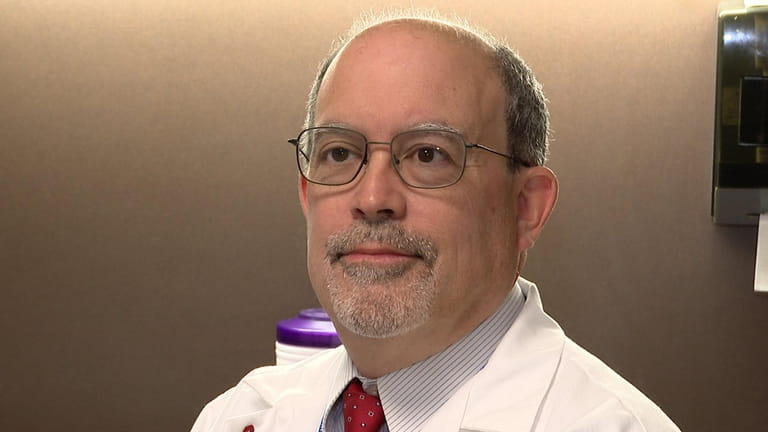
People with HIV tend to have more chronic conditions when they get older and are more likely to die younger from strokes, cardiovascular disease and other conditions, said Dr. Joseph McGowan, who oversees HIV services for Northwell Health. Credit: Anthony Fiorio
HIV remains dangerous, McGowan said. People with HIV tend to have more chronic conditions when they get older and are more likely to die younger from strokes, cardiovascular disease and other conditions, he said. Even when HIV is not listed on death certificates, the virus may have contributed to death by damaging the immune system, he said.
“If you can get on to treatment when your immune system is still relatively intact, you could avoid a lot of these chronic comorbidities,” McGowan said.
Northwell and other Long Island health care providers and organizations focus many of their HIV prevention efforts on Black and Latino communities. But they face major challenges in further reducing HIV transmission.
One is that people are more likely to have sex with others of the same race or ethnicity, McGowan said. There’s no significant racial difference in how many sexual partners people have, but with HIV much more prevalent in Black and Latino communities, Black and Latino people are more likely to have sexual contact with an HIV-positive person, he said.
Disparities in preventive medicine
Compounding this higher risk, Black and Latino people are less likely to take a pre-exposure prophylaxis medication, known as PrEP, that reduces the risk of contracting HIV through sex by 99% when used as prescribed.
Only 11% of Black people and 21% of Latinos "who could benefit from" the preventive medication were prescribed it in 2021, compared with 78% of whites, the CDC says.
“When PrEP came out, it was embraced by the white, gay community,” said Maria Pyra, an assistant professor of medical social sciences and preventive medicine at Northwestern University's medical school in Chicago who studies PrEP access. “Then came the perception that ‘it’s for that group and it’s not for my group of friends or my social circle.’ ”
In addition, the initial focus of recommending PrEP primarily to men who have multiple male sexual partners, and of clinical trials that were limited to men, meant “women didn’t even think it was for them,” Alexander said.
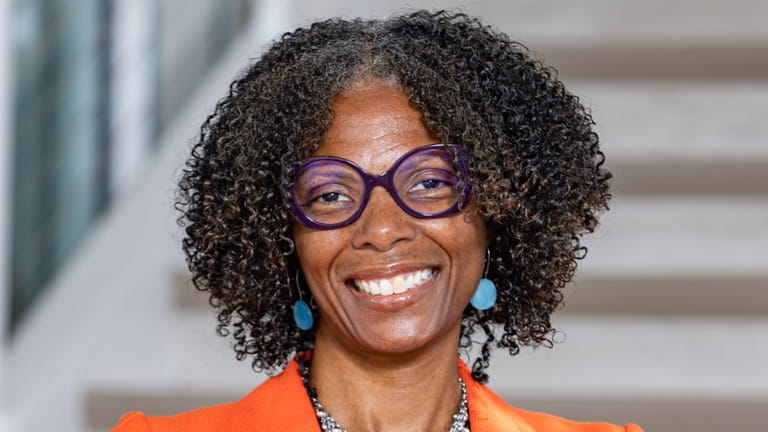
Kamila Alexander, associate professor of nursing at the Johns Hopkins School of Nursing in Baltimore. Credit: Johns Hopkins School of Nursing / Daniel Martinez
Many health care providers don’t know about the medication, with knowledge lower in suburban areas than in cities, and among gynecologists, Pyra said.
Educating Black and Hispanic clinicians about PrEP is especially important, because many people prefer doctors of their own racial and ethnic background, said McGowan, who is helping develop a sexual health and PrEP curriculum for Northwell.
Yet relatively few providers are Black or Latino, and doctors and nurses who aren't have to put in “extra work to build that relationship” and “learn more about what the patient’s life is really like” to provide the most effective preventive and medical care, Alexander said.
“The patient has to get to a place where they feel comfortable enough to open up and disclose enough information so that the provider can tailor that care toward prevention,” she said. “If people are not welcomed or not believed or listened to, experience discrimination and bias from the minute they walk in the door, then they're also not likely to engage or be able to receive the health care that they need.”
Socio-economic status also is a potential barrier to treatment and prevention, said Dr. Janice Verley, who until December was director of the HIV/AIDS program at Nassau University Medical Center, a public hospital in East Meadow. Even as a Black woman, she had to work to gain the trust of some of her low-income patients of color, who won't go to doctors they believe look down on them and make them feel uncomfortable.
“It's sort of like, ‘You live in your home and you drive your car, and you have three meals a day and you go on vacations, you have on a white coat, what do you really know about the struggles that I have, and living in a shelter or living on the street?” Verley said.
Distrust of the medical establishment remains common among Black Americans, because of historic injustices such as experiments done on Black people several decades ago, and attitudes today, like how, as documented in research, doctors are more likely to underestimate the pain of Black patients and prescribe less pain medication, Abdul-Haqq said.
Long Island groups seek to reach Black, Latino communities
Language and cultural differences are other potential hurdles, said Dervis Pulgar, sexual health services manager at the Bellmore-based LGBTQ group PFY, part of the Long Island Crisis Center. Many PFY clients are immigrants from countries where there is greater stigma than in New York toward LGBTQ and HIV-positive people, he said.
“It’s a really big challenge to work with this community," so the sexual-health services staff is entirely bilingual, with three of four staff members Latino and one a transgender Latina woman, said Pulgar, a Venezuelan immigrant.
“They can identify with us, because we are Latinos, too,” he said. “We have the same culture, the same language, the same thinking.”
Loman, the Freeport resident, said when he led a Spanish-speaking LGBTQ support group at PFY, immigrants, especially undocumented ones, said they didn’t regularly see doctors or seek HIV testing because they didn’t have insurance. He told them about free HIV tests and low-cost medical care.
Loman said his HIV infection would have been caught earlier if he didn’t mistakenly believe a test was expensive. He got diagnosed with HIV only after he went to the hospital in 2013 with severe stomach pain. Today, he still has “really bad gastritis” and irritable bowel syndrome, and doctors told him it was because of how low his T-cell level had fallen.
“My stomach situation probably would have been totally different if I had been in treatment sooner,” he said.
Black and Latino communities have higher rates of poverty than white and Asian ones, and HIV disproportionately strikes the poor.
Low-income people have more stressors in life, “trying to keep a roof over your head, trying to keep food in your mouth and your children’s mouths,” said Juanita Carter-Fuller, 66, a Black HIV-positive woman who lives in Wyandanch and is a community outreach specialist for Northwell’s Center for AIDS Research and Treatment.
For them, HIV testing or care may not be a priority, so Northwell helps connect them with stable housing, jobs and other services, McGowan said.
Patchogue-based Thursday’s Child, which offers HIV prevention and services, focuses much of its HIV testing in communities with large Black and Latino populations, program manager Kerry Thomas said.
On a recent afternoon at the Family Service League health center in Bay Shore, Thursday’s Child HIV testing program specialists Neika Chery, who speaks Haitian Creole, and Jennifer Jara, who speaks Spanish, were staffing an HIV-testing table.
“Seeing someone that's Black, or seeing someone that's Hispanic, or someone that represents them, it makes it more comfortable to come to our tables, ask questions, and get testing, which is the goal, so we can help them get services if they're positive,” Chery said.
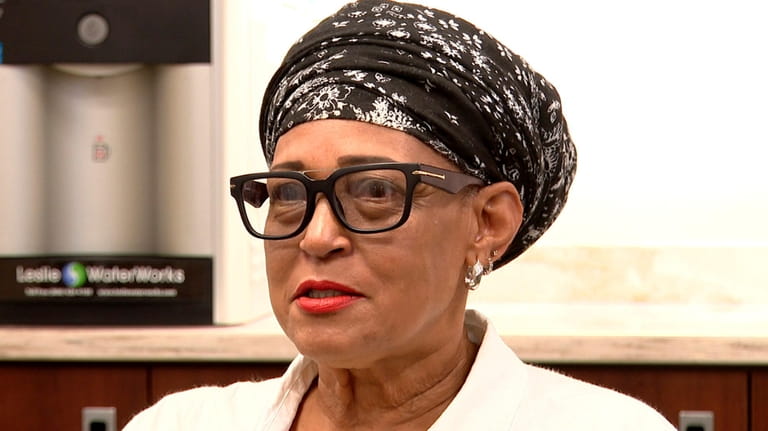
Juanita Carter-Fuller, who is HIV-positive and an outreach worker, said the stigma around HIV and AIDS remains. Credit: Anthony Fiorio
Long Beach-based Círculo de la Hispanidad, which offers an array of HIV services, weaves some of its HIV prevention and education into other initiatives, including English as a Second Language classes, HIV program director César Nuesi said. All ESL students hear the presentations, under the philosophy that “any human being who is sexually active can be at risk for HIV and STDs,” he said.
Prevention outreach to women is especially challenging, because many “see themselves at low risk,” said Barbara Martens, who manages community engagement for Northwell’s AIDS services. “The problem is that their sexual partners are not.”
The most effective HIV messaging toward people of color is narrowly targeted — for example, toward Black women, to underline that they, too, are at risk, Abdul-Haqq said.
One-on-one engagement can be especially effective, she said.
Northwell trains barbers, beauticians and others in communities of color with higher HIV rates to talk to clients about HIV, and to distribute condoms and educational materials, Martens said. Testing vans periodically are set up outside the businesses. Northwell also has “social media influencers” in those communities to promote events and materials, McGowan said.
HIV/AIDS stigma magnified
Societal stigma toward LGBT and HIV-positive people leads some to avoid getting tested or, once they’re HIV-positive, to shun care, doctors and HIV outreach workers said.
“They’re looking around hoping that nobody will see them walk into a van to get tested,” Carter-Fuller said.
That same stigma means that people who live with their families may not want to get a PrEP or HIV-medicine prescription for fear the pills will be discovered, she said.
Stigma exists in white as well as Black and Latino communities, Alexander said. But in low-income communities of color, that stigma is magnified by other issues, so someone who hides their HIV status won’t ask to borrow a car or money for a medical appointment, she said.
On Long Island, spotty bus service makes it less likely people without cars will go to the doctor, Nuesi said.
“If you don’t drive, it can take you half the day, one day, for your medical appointment,” so Círculo provides ride-share, taxi and other services, he said.
Those appointments often are far from people’s homes because major health care providers typically don’t have offices and clinics in the low-income areas where HIV risk is highest, preferring to locate where more people have private insurance, McGowan said.
Someone without insurance is less likely to have a primary care provider who could diagnose HIV early on, before the virus does too much damage to the body, and before someone may unknowingly spread the virus to others, he said.
Nonprofit federally qualified health centers in both counties serve many people without insurance or with Medicaid.
Pam Biafora is a peer adherence worker for one of them, Sun River Health, which has centers across Suffolk.
Biafora, who has been HIV-positive since 1986 and is of half Puerto Rican ancestry, regularly reviews HIV-positive patients’ charts and calls them if they’re overdue for an appointment — and delves into why. “There’s a safe space” when she talks with a fellow HIV-positive person, she said.
Biafora, 60, is grateful to have survived, when so many who got HIV in the 1980s died. But she mourns how she was not able to fulfill her dream of having a child.
Unlike today, when HIV medicine taken while pregnant and given to a newborn reduces the risk of maternal transmission to less than 1%, according to the CDC, the probability was much higher during Biafora’s childbearing years. She did not want to take the chance of having an HIV-positive baby.
“That’s been my biggest regret,” she said, “something I just can’t forgive HIV from taking away from me.”

